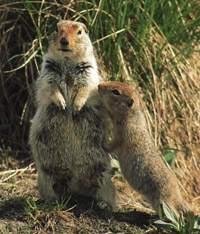
 |
|
 |
|||
| Population limitation and regulation of arctic ground squirrel populations: density-dependent and independent factors
From 1993-1998 my research focused on the ecological mechanisms of what limits and regulates populations of arctic ground squirrels (Spermophilus parryii) living in the boreal forests of the southwest Yukon Territory, Canada, in collaboration with Dr. Rudy Boonstra, University of Toronto, Canada. This was a large-scale experimental manipulation of food supply and predator abundance as part of the Kluane Boreal Forest Ecosystem Project. |
|||
 |
Population limitation and regulation of hoary marmot populations: the role of sociality and climate variability
In collaboration with Dr. David Hik, University of Alberta, Canada, we have been investigating the interactions between climate variability and demography in a population of hoary marmots (Marmota caligata) in the southwest Yukon Territory since 1999. Our research has focused on determining how annual variablity in spring conditions influence reproduction and survival of marmots. We are also investigating the role of sociality and the mechanisms by which sociality works to regulate marmot populations in a severe and highly variable environment. |
||
 |
Resource allocation during reproduction and sex allocation in offspring Since April 2003, I have been conducting research in life history of Columbian ground squirrels (Spermophilus columbianus) in the Kananaskis region of Alberta, Canada in collaboration with Dr. F. Stephen Dobson at Auburn University, Alabama. For this project we are conducting experimental manipulations of food resources and litters of female ground squirrels to examine tradeoffs in allocation of capital versus income resources to growth and reproduction. We are also conducting formal tests of multiple hypotheses of sex allocation in offspring. Our research will continue to investigate tradeoffs between number and size of offspring. |
||
| CSUN Biology Home Page | Karels Home Page | Publications | ||||||